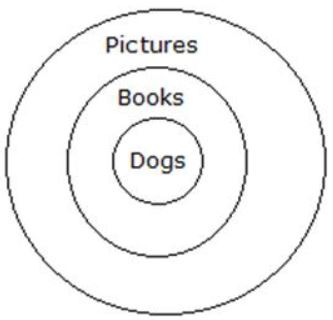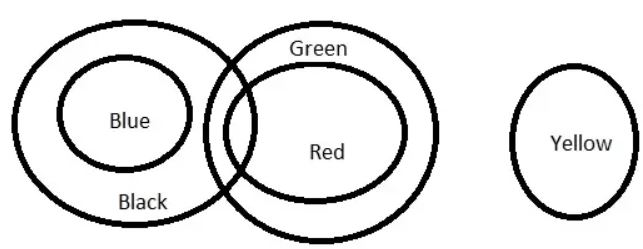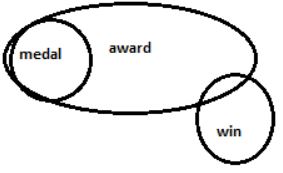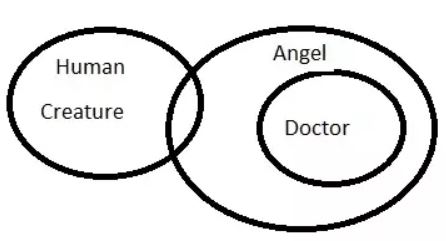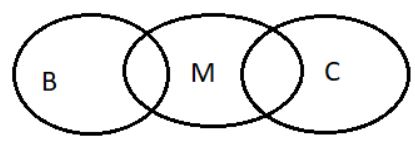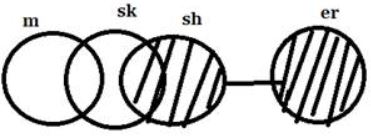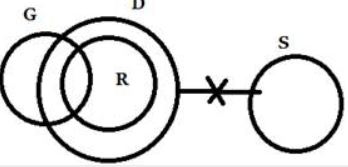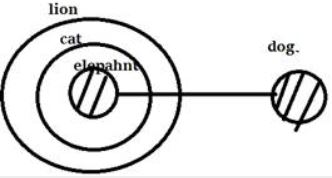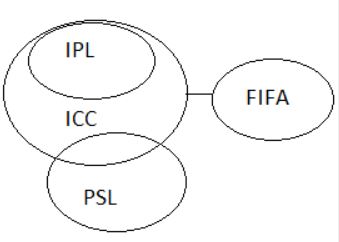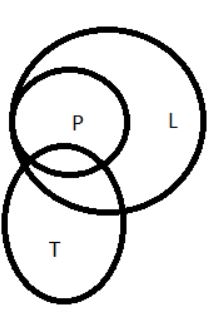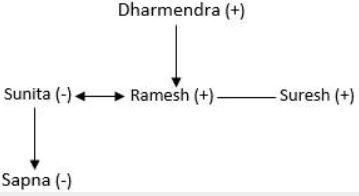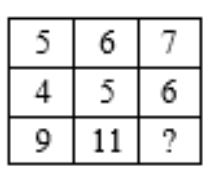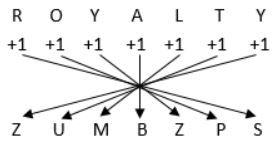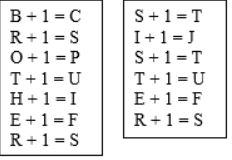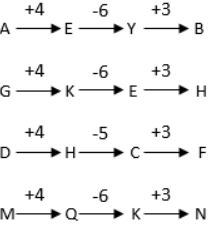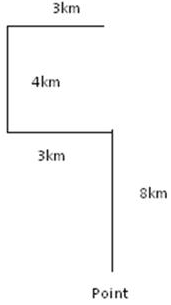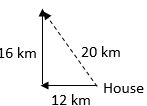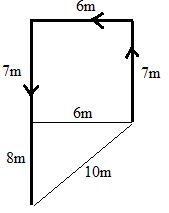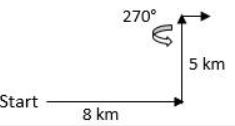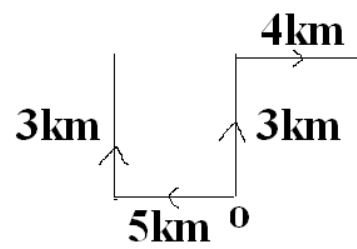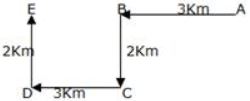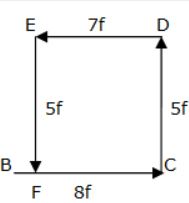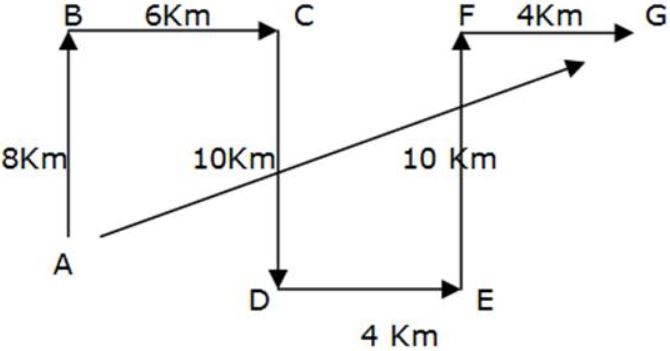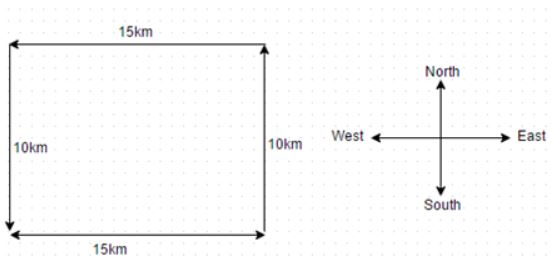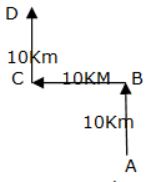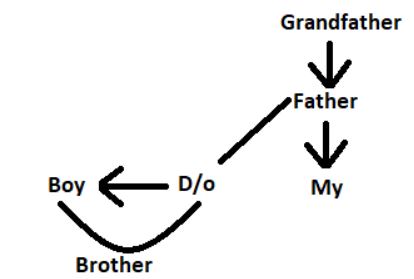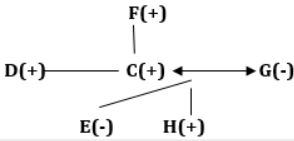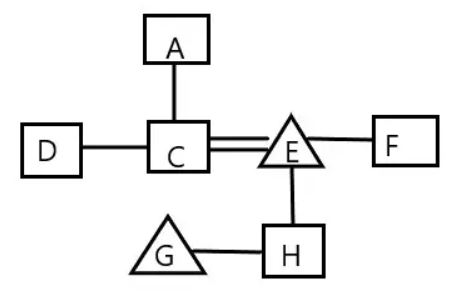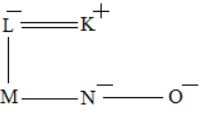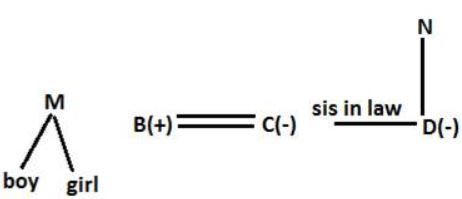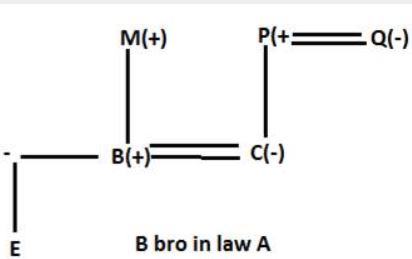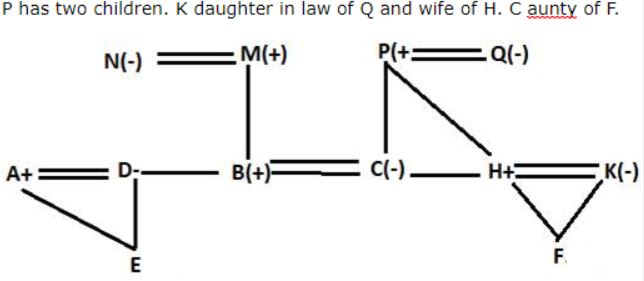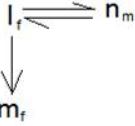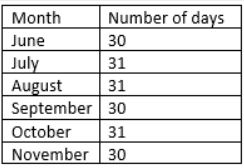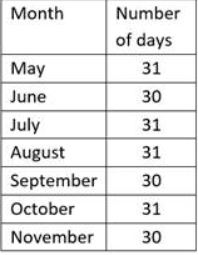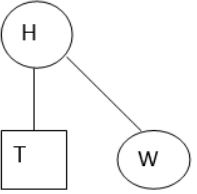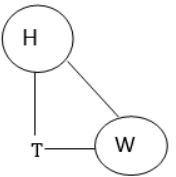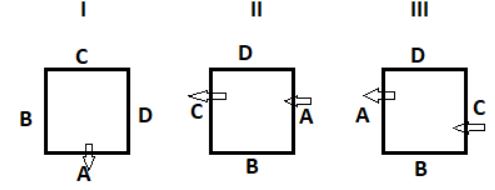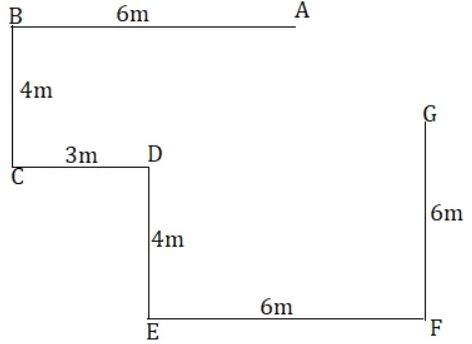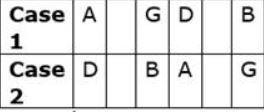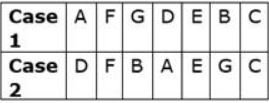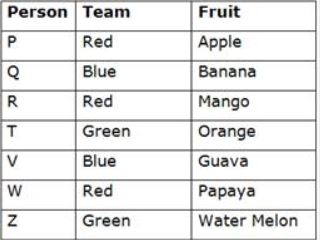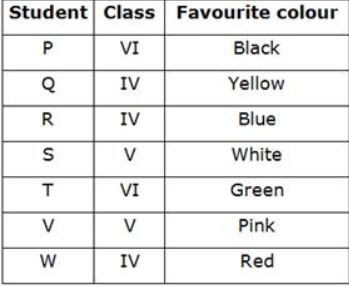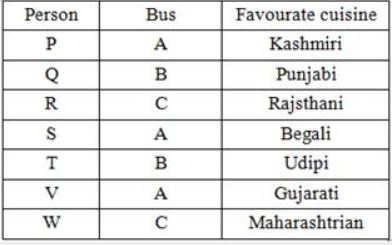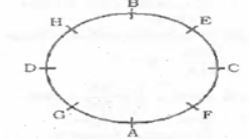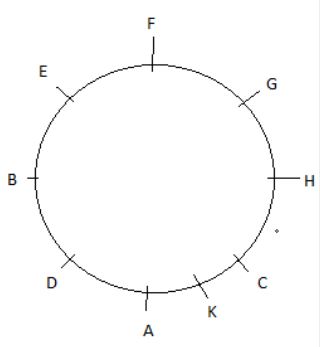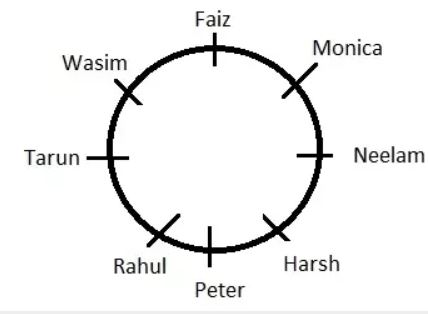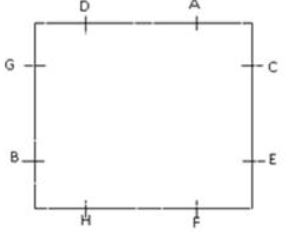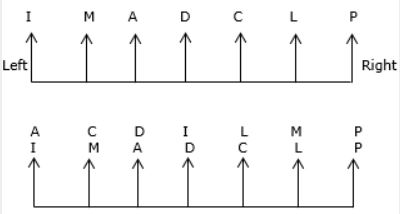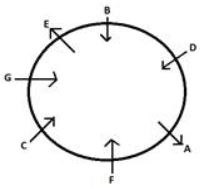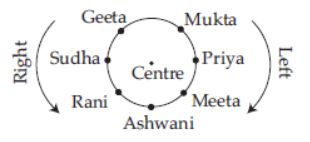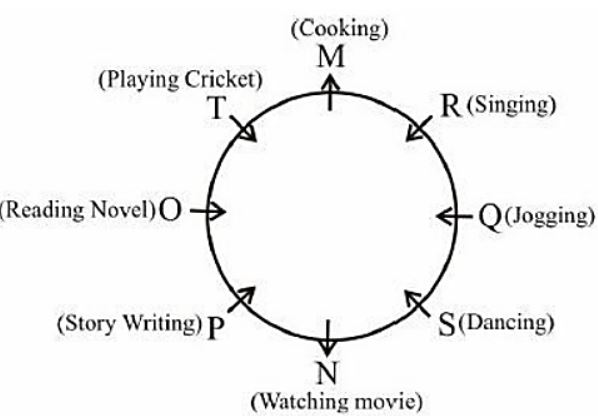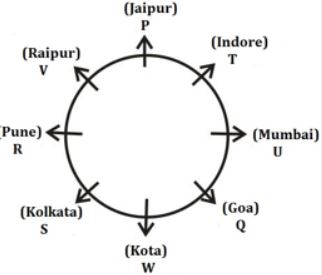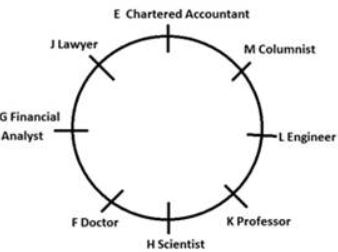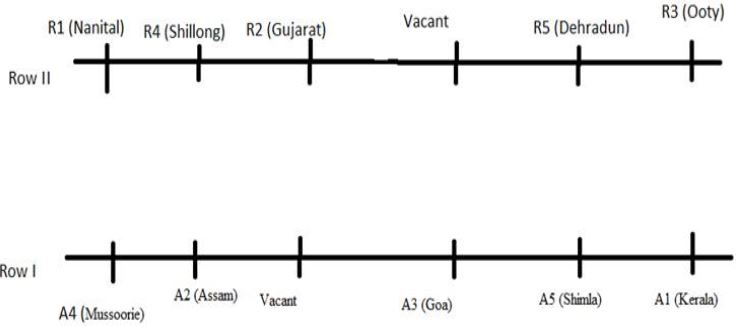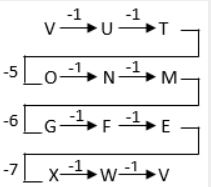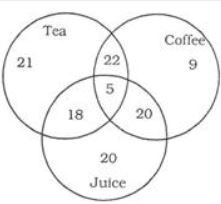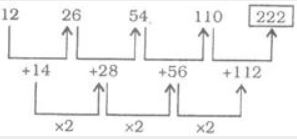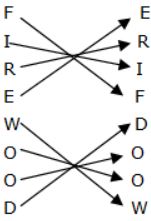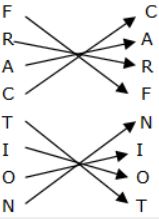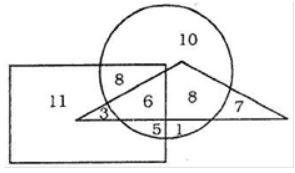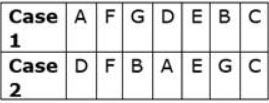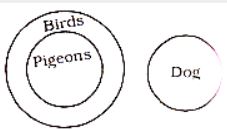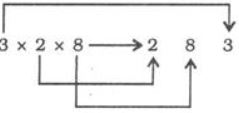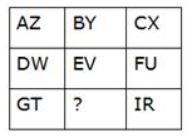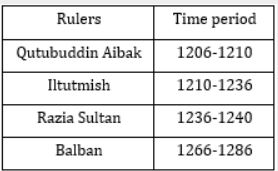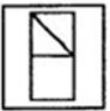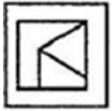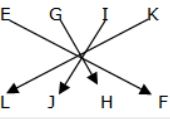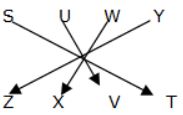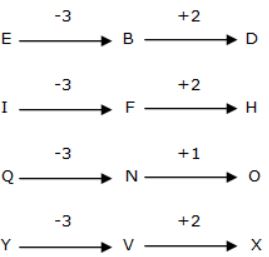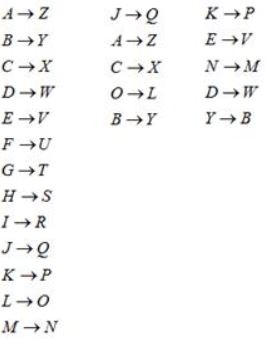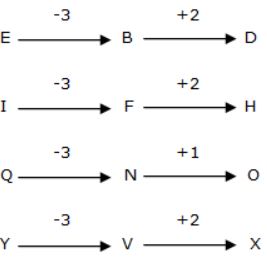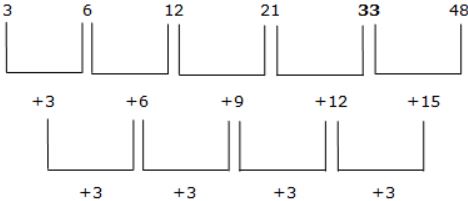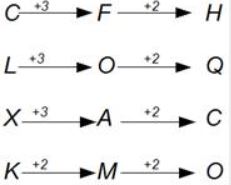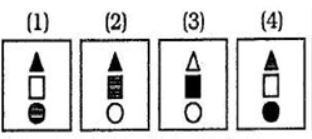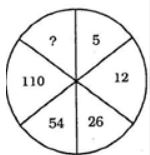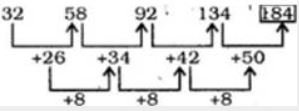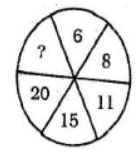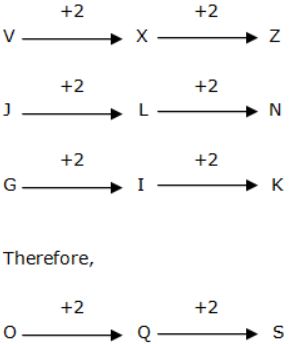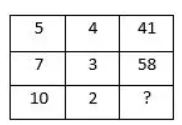 Introduction
Introduction
What is reasoning and its types?
Reasoning is the process of using existing knowledge to draw conclusions, make predictions, or construct explanations. Three methods of reasoning are the deductive, inductive, and abductive approaches. Deductive reasoning: conclusion guaranteed.
The article RRB JE 2019 Reasoning Ability Quiz provides Reasoning Ability questions with answers useful to the candidates preparing for Competitive exams, Entrance exams, Interviews etc. Railway Recruitment Board (RRB) has released RRB JE 2019 Official Notification to recruit eligible candidates for the post of it Railway JE Recruitment 2018-19 will be held to recruit candidates for the posts of Junior Engineer(JE), Junior Engineer(Information Technology), Depot Material Superintendent(DMS) and Chemical & Metallurgical Assistant(CMA).Reasoning Ability plays major role to qualify examination. The article RRB JE 2019 Reasoning Ability Quiz will assist the students understand the type of questions expected from the topic Reasoning Ability .
Click Here for RRB JE official website
 Quiz
Quiz
1. Direction: In the following question, one/two statements are given followed by two conclusions (I) and (II). You have to consider the two statements to be true even if they seem to be at variance from commonly known facts. You have to decide which of the given conclusions, if any, follow from the given statements.
Statements :
Some books are Magazines.
Some Magazines are Novels.
Conclusions :
(I) Some books are Novels.
(II) Some Novels are Magazines.
- A. Only (I) follows
B. Only (II) follows
C. Either (I) or (II) follows
D. Neither (I) nor (II) follows
- A. Only conclusions I follows
B. Only conclusions II follow
C. Either conclusions I or II follows
D. Neither conclusions I nor II follows
- A. Only inference I follows
B. Only inference II follows
C. Both inferences I and II follow
D. Neither of the two inferences follows
- A. Only I and IV follow
B. Only II and III follow
C. Either II or III follows
D. Either I or IV follows
- A. Either II or III follows
B. Either II or IV follows
C. Either I or III follows
D. None of the conclusions follow
- A. Only (I) follows
B. Only (II) follows
C. Conclusions (I) and (II) follow
D. Neither (I) nor (II) follows
- A. Only I and II follow
B. Only II and IV follow
C. Only I and III follow
D. Only I, II and IV follow
- A. Both conclusions I and II follow
B. Neither conclusion I nor II follows
C. Only conclusion I follows
D. Only conclusion II follows
- A. Only I follows
B. Only II follows
C. Either I or II follows
D. Neither I nor II follows
- A. Only conclusion I follows
B. Only conclusion II follows
C. Both conclusions I and II follow
D. Neither conclusion I nor II follows
1. Direction: In the question below are given three statements followed by three conclusions number I, II and III. You have to take the given statements to be true even if they seem to be at variance from commonly known facts. Read the entire conclusion and then decide which of the given conclusions logically follows from the given statements disregarding commonly known facts.
Statements:
Some marker are sketch.
Some sketch are sharpener.
No sharpener is eraser.
Conclusions:
I. Some eraser is sketch.
II. Some eraser is sharpener is a possibility.
III. All sketch can be eraser
- A. None follows
B. only II follows
C. only III follows
D. only I follows
- A. only I and II follow
B. only I and III follow
C. only II and III follow
D. All I, II and III follow
- A. Only I follows
B. Only II follows
C. Only III follows
D. All follow
- A. Only conclusion A follows.
B. Only conclusion B follows.
C. Either conclusion A or B follows.
D. Neither conclusion A nor B follows.
- A. Only I and II follow
B. Only III follows
C. Only I follows
D. None follows
- A. Only I follow
B. Only II follow
C. Neither I nor II follows
D. All follow
- A. Only I follow
B. Only II follow
C. Neither I nor II follows
D. All follow
- A. Only I follow
B. Only II follow
C. Neither I nor II follows
D. All follow
- A. Only I follows
B. Only II follows
C. Either I or II follows
D. Both I and II follow
- A. if only conclusion I follows
B. if only conclusion II follows
C. if either conclusion I or conclusion II follows.
D. if neither conclusion I nor conclusion II follows
1. Direction: In each of the following questions, two statements are given followed by two/four conclusions I, II, III and IV. You have to consider the two statements to be true even if they seem to be at variance from commonly known facts. You have to decide which of the given conclusions, if any, follow from the given statements.
Statement:
1. All peacocks are lions.
2. Some tigers are peacocks.
Conclusions :
I. Some lions are not tigers.
II. All tigers are lions.
III. Some tigers are lions.
IV. All peacocks are tigers.
- A. Only conclusion III follows
B. Only conclusion IV follows
C. Only conclusion I follows
D. Only conclusion II follows
- A. All the conclusions follow
B. None of conclusions follow
C. Either I or II follows
D. Only IV follows
- A. 5 years
B. 10 years
C. 15 years
D. 20 years
- A. Daughter
B. Sister-in-law
C. Niece
D. Granddaughter
- A. REMEREBM
B. MBEREMER
C. MBERREME
D. MBERREEM
- A. 46 km
B. 34 km
C. 40 km
D. 38 km
- A. 19
B. 1
C. 21
D. 13
- A. 10 2 3 5 16 4 7 8 9
B. 3 1 2 4 5 7 6 9 8 10
C. 1 3 5 2 9 4 8 6 7 10
D. 9 1 3 6 2 7 54 8 10
- A. PE
B. QD
C. NM
D. OF
- A.
B.
C.
D.
1. In a certain code language, “TRUMP” is written as “46321” and “GRAIN” is written as “76598”. How is “GRUNT” written in that code language?
- A. 23684
B. 23847
C. 67834
D. 76384
- A. 612311
B. 612531
C. 456789
D. 612351
- A. 84172563
B. 84172564
C. 84173256
D. 84172566
- A. 261739
B. 266734
C. 231954
D. 201739
- A. SFMJFMFE
B. SEOIJVLD
C. SGOMJBLL
D. SGOMJVED
- A. ACBCCTG
B. ACACCTG
C. EGFINBI
D. BFCCTGL
- A. SFHJOM
B. SFHOJM
C. SHFOJM
D. SHFOMJ
- A. TJTFUS
B. TJTUFS
C. SFUTJT
D. TJTSFU
- A. 181520
B. 181025
C. 181205
D. 181914
- A. 89872
B. 89896
C. 89895
D. 89897
1. Direction: Select the related word/letters/ number from the given alternatives.
AEG: GKM :: MQS : ?
- A. SWY
B. SWZ
C. ZWQ
D. SWB
- A. E
B. B
C. C
D. D
- A. 4, 1, 5, 2, 3
B. 3, 2, 1, 5, 4
C. 2, 1, 4, 5, 3
D. 1, 5, 4, 2, 3
- A. Teacher
B. Doctor
C. Police
D. Lawyer
- A. HATEBR
B. HTAERB
C. HTBREA
D. HEATRB
- A. 45 years, 25 years
B. 50 years, 20 years
C. 47 years, 23 years
D. 50 years, 25 years
- A. KJML
B. GFIH
C. TSVU
D. ZABY
- A. Malnutrition
B. Illiteracy
C. Drought
D. Death
- A. 122 - 1331
B. 173 - 2197
C. 197 - 2744
D. 290 - 4913
- A. TRQO
B. WUTR
C. JHFD
D. LJIG
1. In the following question, select the odd word from the given alternatives.
- A. Constellation
B. Galaxy
C. Star
D. Cluster
- A. DFH
B. QSU
C. MOQ
D. VWX
- A. 43-6
B. 28-4
C. 50-7
D. 36-5
- A. Moon
B. Mars
C. Saturn
D. Jupiter
- A. 13
B. 17
C. 21
D. 23
- A. AEYB
B. GKEH
C. DHCF
D. MQKN
- A. 361
B. 289
C. 225
D. 256
- A. Book
B. Page
C. Pen
D. Diary
- A. 341
B. 342
C. 810
D. 405
- A. DV
B. GR
C. FT
D. JP
1. Rahul leaves his home and walks 5 km towards east, turns in the south-east direction and walks for 10km, then he turns north-east and moves 10 km. Again, he moves towards the north for 10km. In which direction is he now from starting point?
- A. West
B. East
C. North-east
D. North-west
- A. 18 km
B. 11 km
C. 12 km
D. 15 km
- A. East
B. West
C. South
D. North
- A. 6 km
B. 10 km
C. 4 km
D. 14 km
- A. 60 m
B. 35 m
C. 40 m
D. 45 m
- A. 26 kms
B. 8 kms
C. 22 kms
D. 4 kms
- A. 13 km South
B. 13 km North
C. 15 km West
D. 20 km North-West
- A. 185 metre
B. 180 metre
C. 160 metre
D. 165 metre
- A. 10m, North east
B. 10m, North west
C. 10m, South east
D. 10m, South west
- A. North
B. South-West
C. North-East
D. South
1. Vishal travels 8 km towards east, then turns left and travels another 5 km, and then he turns 270 degrees anticlockwise. Which direction is he facing now?
- A. West
B. East
C. North
D. South
- A. 13 km
B. 16 km
C. 9 km
D. 10 km
- A. 4 km
B. 6 km
C. 8 km
D. 10 km
- A. East
B. West
C. North
D. South
- A. 3 feet
B. 4 feet
C. 1 feet
D. 5 feet
- A. South
B. North East
C. South East
D. North
- A. West
B. South
C. North
D. East
- A. 6 m
B. 4 km
C. 10 km
D. 8 km
- A. 10 km
B. 5 km
C. 12 km
D. 15 km
- A. South
B. North
C. East
D. West
1. Introducing a man, a woman says, "His son's mother is the only daughter of my mother". How is the man related to the woman?
- A. Nephew
B. Maternal uncle
C. Husband
D. Father
- A. Cousin
B. Father
C. Nephew
D. Brother
- A. Son
B. Grandson
C. Father
D. Cousin
- A. Sister in law
B. Granddaughter
C. Wife
D. Daughter
- A. Uncle
B. Brother
C. Grandson
D. Grandfather
- A. Nephew
B. Grandfather
C. Son
D. Uncle
- A. Mother
B. Aunt
C. Sister
D. Cousin
- A. Mother
B. Daughter
C. Aunt
D. Niece or daughter
- A. Wife
B. Mother
C. Sister
D. Daughter
- A. Sister-in-law
B. Sister
C. Cousin
D. Nephew
1. Direction: Read the following information carefully to answer the following questions.
There are six persons C, D, E, F, G and H in a family. There are two fathers and a mother in the family. E is the sister of H. D is the brother of G’s husband. F is the father of C and grandfather of H. G has only one daughter.
- A. C
B. E
C. G
D. H
- A. Grandson
B. Granddaughter
C. Son
D. Cannot be determined
- A. Daughter-in-law
B. Son-in-law
C. Son
D. Daughter
- A. Grandson
B. Cannot be determined
C. Daughter in law
D. Son in law
- A. Madhav
B. Krishna
C. Gaur
D. Radhey
- A. 12
B. 13
C. 15
D. 17
- A. Brother-in-law
B. Brother
C. Son-in-law
D. Cousin
- A. Mother-in-law
B. Sister
C. Daughter
D. Sister-in-law
- A. Father
B. Mother
C. Cousin
D. Son
- A. l ÷m × n
B. l - m × n
C. l + m × n
D. l + m ÷ n
1. If [latex]{5}^{th}[/latex] January 2011 was a Thursday, then what day of the week was it on [latex]{1}^{st}[/latex] January 2013?
- A. Thursday
B. Wednesday
C. Tuesday
D. Monday
- A. Today
B. Tomorrow
C. Day after tomorrow
D. Two days after tomorrow
- A. Thursday
B. Friday
C. Tuesday
D. Wednesday
- A. Saturday
B. Thursday
C. Friday
D. Sunday
- A. Thursday
B. Friday
C. Saturday
D. Sunday
- A. 3 days after today
B. Tomorrow
C. Today
D. Day after tomorrow
- A. 6 September 2029
B. 18 August 2029
C. 8 November 2029
D. 29 November 2029
- A. Friday
B. Wednesday
C. Saturday
D. Thursday
- A. 8hrs 9 minutes [latex]{\frac {9}{10}}^{th}[/latex] minute.
B. 8hrs 10 minutes [latex]{\frac {10}{11}}^{th}[/latex] minute.
C. 8hrs 11 minutes [latex]{\frac {11}{12}}^{th}[/latex] minute.
D. 8hrs 12 minutes [latex]{\frac {11}{13}}^{th}[/latex] minute.
- A. Thursday
B. Sunday
C. Friday
D. Monday
1. Akshar remembers that the match is after [latex]{26}^{th}[/latex] April but before [latex]{30}^{th}[/latex] April, while Suresh remembers that the match is after [latex]{22}^{nd}[/latex] April but before [latex]{28}^{th}[/latex] April. On which date of April is the match?
- A. 29
B. 26
C. 27
D. 28
- A. Tuesday
B. Friday
C. Wednesday
D. Saturday
- A. Wednesday
B. Friday
C. Saturday
D. Sunday
- A. 7:05
B. 7:55
C. 5:05
D. 5:55
- A. Friday
B. Thursday
C. Tuesday
D. Sunday
- A. Monday
B. Wednesday
C. Tuesday
D. Thursday
- A. Friday
B. Monday
C. Tuesday
D. Saturday
- A. Monday
B. Friday
C. Wednesday
D. Sunday
- A. Monday
B. Friday
C. Thursday
D. Sunday
- A. 2000
B. 2004
C. 1996
D. 1996
1. Direction: Each of the questions below consists of a question and two statements numbered I and II given below it. You have to decide whether the data provided in the statements are sufficient to answer the questions. Read both the statements and Give Answer City F is towards which direction of City D?
I. City D is towards south of City of K which is towards west of City F
II. City M is towards south of City R and towards east of City D
- A. the data in statement I alone are sufficient to answer the question, while the data in statement II
alone are not sufficient in answer the question.
B. the data in statement II alone are sufficient to answer the question, while the data in statement I
alone are not sufficient to answer the question.
C. the data in either in statement I alone or in statement II alone are sufficient to answer the question
D. the data in both the statements I and II together are not sufficient to answer the question.
- A. If data in both statement I and II together are necessary to answer the questions.
B. If data in statements II sufficient to answer the question, while the data in statement I are not
required to answer the question
C. If data in statements either I or II are sufficient to answer the question
D. If data in statements I sufficient to answer the question while the data in statement II are not required
to answer the question.
- A. The data in statement I alone is sufficient to answer the question, while the data in statement II alone
is not sufficient to answer the question.
B. The data in statement II alone is sufficient to answer the question, while the data in statement II
alone is not sufficient to answer the question.
C. The data either in statement I alone or in statement II alone is sufficient to answer the question.
D. The data in both the statement I and II together is not sufficient to answer the question.
- A. The data in statement I alone is sufficient to answer the question, while the data in statement II alone
is not sufficient to answer the question.
B. The data in statement II alone is sufficient to answer the question, while the data in statement I alone
is not sufficient to answer the question.
C. The data either in statement I alone or in statement II alone is sufficient to answer the question.
D. The data in both the statements I and II together are necessary to answer the question
- A. Data in statement I alone or in the statement II alone or in the statement III alone is sufficient to
answer the question
B. Data in statement II and III are sufficient to answer the question, while the data in statement I is not
sufficient to answer the question.
C. Data in all the statement I, II and III are necessary to answer the question.
D. Data in statement I and III are sufficient to answer the question, while the data in statement II is not
sufficient to answer the question.
- A. The data in statement I alone are sufficient to answer the question, while the data in statement II
alone are not sufficient to answer the question.
B. The data in statement II alone are sufficient to answer the question, while the data in statement I
alone are not sufficient to answer the question.
C. The data either in statement I alone or in statement II alone are sufficient to answer the question.
D. The data in both the statements I and II together are not sufficient to answer the question.
- A. The data in statement I alone are sufficient to answer the question, while the data in statement II
alone are not sufficient to answer the question.
B. The data in statement II alone are sufficient to answer the question, while the data in statement I
alone are not sufficient to answer the question.
C. The data either in statement I alone or in statement II alone are sufficient to answer the question
D. The data in both the statements I and II together are necessary to answer the question.
- A. The data in statement I alone are sufficient to answer the question, while the data in statement II
alone are not sufficient to answer the question.
B. The data in statement II alone are sufficient to answer the question, while the data in statement I
alone are not sufficient to answer the question.
C. The data either in statement I alone or in statement II alone are sufficient to answer the question.
D. The data in both the statements I and II together are not sufficient to answer the question.
- A. The data in statement I alone are sufficient to answer the question, while the data in statement II
alone are not sufficient to answer the question.
B. The data in statement II alone are sufficient to answer the question, while the data in statement I
alone are not sufficient to answer the question.
C. The data either in statement I alone or in statement II alone are sufficient to answer the question.
D. The data in both the statements I and II together are not sufficient to answer the question.
- A. If the data in statement I alone are sufficient to answer the question, while the data in statement II
alone are not sufficient to answer the question.
B. If the data in statement II alone are sufficient to answer the question, while the data in statement I
alone are not sufficient to answer the question.
C. If the data either in statement I alone or in statement II alone are sufficient to answer the question
D. If the data in both the statements I and II together are necessary to answer the question.
1. Direction: The following question below consists of a question and two statements numbered I and II given below it. You have to decide whether the data provided in which of the statements are sufficient to answer the question. Choose your answer from the options based on this.
Seven persons A, B, C, D, E, F and G are sitting in a straight line and facing north. Who among the following is sitting exactly in the middle?
I. A is 2nd to the left of G. Two persons are sitting between G and B. D is 2nd to the left of B.
II. B is 2nd to the right of D. E is 2nd to the left of C. Two persons are sitting between F and E.
- A. If the data in statement I alone are sufficient to answer the question, while the data in statement II alone are not sufficient to answer the
question.
B. If the data in statement II alone are sufficient to answer the question, while the data in statement I alone are not sufficient to answer the
question.
C. If the data either in statement I alone or in statement II alone are sufficient to answer the question.
D. If the data in both the statements I and II together are not sufficient to answer the question
- A. The data in statement I alone are sufficient to answer the question, while the data in statement II alone are not sufficient to answer the
question.
B. The data in statement II alone are sufficient to answer the question, while the data in statement I alone are not sufficient to answer the
question.
C. The data either in statement I alone or in statement II alone are sufficient to answer the question.
D. The data in both the statements I and II together are necessary to answer the question
- A. Data in statement I alone are sufficient to answer the question, while the data in statement II alone are not sufficient to answer the
question
B. Data in statement II alone are sufficient to answer the question, while the data in statement I alone are not sufficient to answer the
question
C. Data either in statement I alone or in statement II alone are sufficient to answer the question
D. Data given in both the statement I & II together are not sufficient to answer the question
- A. Data in statement I alone are sufficient to answer the question, while the data in statement II alone are not sufficient to answer the
question
B. Data in statement II alone are sufficient to answer the question, while the data in statement I alone are not sufficient to answer the
question
C. Data either in statement I alone or in statement II alone are sufficient to answer the question
D. Data given in both the statement I & II together are not sufficient to answer the question
- A. The data in statement I alone are sufficient to answer the question, while the data in statement II alone are not sufficient to answer the
question
B. The data in statement II alone are sufficient to answer the question, while the data in statement I atone are not sufficient to answer the
question.
C. The data either in statement I alone or in statement II alone are sufficient to answer the question
D. The data given in both the statements I and II together are not sufficient to answer the question.
- A. The data in statement I alone are sufficient to answer the question, while the data in statement II alone are not sufficient to answer the
question
B. The data in statement II alone are sufficient to answer the question, while the data in statement I atone are not sufficient to answer the
question.
C. The data either in statement I alone or in statement II alone are sufficient to answer the question
D. The data given in both the statements I and II together are not sufficient to answer the question.
- A. The data in statement I alone are sufficient to answer the question, while the data in statement II alone are not sufficient to answer the
question
B. The data in statement II alone are sufficient to answer the question, while the data in statement I atone are not sufficient to answer the
question.
C. The data either in statement I alone or in statement II alone are sufficient to answer the question
D. The data given in both the statements I and II together are not sufficient to answer the question.
- A. The data in statement I alone are sufficient to answer the question, while the data in statement II alone are not sufficient to answer the
question
B. The data in statement II alone are sufficient to answer the question, while the data in statement I atone are not sufficient to answer the
question.
C. The data either in statement I alone or in statement II alone are sufficient to answer the question
D. The data given in both the statements I and II together are not sufficient to answer the question.
- A. The data in statement I alone are sufficient to answer the question, while the data in statement II alone are not sufficient to answer the
question
B. The data in statement II alone are sufficient to answer the question, while the data in statement I atone are not sufficient to answer the
question.
C. The data either in statement I alone or in statement II alone are sufficient to answer the question
D. The data given in both the statements I and II together are not sufficient to answer the question.
- A. The data in statement I alone are sufficient to answer the question, while the data in statement II alone are not sufficient to answer the
question
B. The data in statement II alone are sufficient to answer the question, while the data in statement I atone are not sufficient to answer the
question.
C. The data either in statement I alone or in statement II alone are sufficient to answer the question
D. The data given in both the statements I and II together are not sufficient to answer the question.
1. Direction: In the following questions, the symbols d, %, *, @ and © are used with the following meaning as illustrated below:
‘P%Q’ means ‘P is not smaller than Q’.
‘P ©Q’ means ‘P is not greater than Q’.
‘PdQ’ means ‘P is neither greater than nor equal to Q’.
‘P@Q’ means ‘P is neither smaller than nor equal to Q’.
‘P*Q’ means ‘P is neither greater than nor smaller than Q’.
Now in each of the following questions, assuming the given statements to be true, find which of the two conclusions I and II given below them is/are definitely true?
Statement:
M @ T, T % R, R * K
Conclusion:
I. K © T
II. M @ K
- A. Only Conclusion I is true
B. Only Conclusion II is true
C. Either Conclusion I or II is true
D. Both Conclusions I and II is true
- A. Only Conclusion I is true
B. Only Conclusion II is true
C. Either Conclusion I or II is true
D. Neither conclusion I nor II is true.
Q IV. O < MA. Only II B. I and either II or III only C. Either II or III only D. None of these
Answer - Option D Explanation : From the given statement, M = N = O > P < Q No information is obtained about the relationship between Q and O or between N and Q. Also, O>M is definitely false. O can be greater than, lesser than or equal to Q. II and III cover only 2 conditions. Hence none of the conclusions is true. 4. Direction: In each of these question, the relationships between two or more elements are shown in the statements. These statements are followed by two conclusions. Read the statements and give answer. Statement: A > B D = E > F Conclusion: I. B < A II. C = EA. Only Conclusion I is true B. Only Conclusion II is true C. Either Conclusion I or II is true D. Neither conclusion I nor II is true.
Answer - Option A Explanation : (i)A > B means B E. Thus, II does not follow. 5. Which of the following expressions has B>F and D>G definitely true?A. A<B=C<D=F=G<E B. G<A=C<DF<B C. E>C=B=D=G=A>F D. D=B=E=F<G=A<C
Answer - Option B Explanation : G<A=C<DF<B 6. Which of the following expressions is definitely true if the given expressions 'IH’ are definitely true?A. J>K=I>H>G B. J>K=I>H<G C. H>I=K>G=J D. G>H=I=K
Answer - Option D Explanation : In the expression G>H=I=K<J, both the conditions are fulfilled. 7. Direction: In the following question, some statements are followed by some conclusions. Assuming the given statements to be true, find which of the two conclusions follow(s) the given statements and choose appropriate answer choice. Statement: M > N = O = P, Q = R = S = P Conclusion: I. O = R II. M > SA. Only conclusion I is true. B. Only conclusion II is true. C. Either conclusion I or II is true. D. Both conclusion I and II are true.
Answer - Option D Explanation : I. O=P & P=R which means O=R II. M>P & P=S which means M>S 8. In which of the following expressions will the expression ‘P < Q’ be definitely true?A. P = R > N = Q B. Q P C. P N D. P = N = M > Q
Answer - Option C Explanation : In P < RN, P < Q is definitely true. Option C is the correct answer. 9. Directions: Now in each of the following questions, assuming the given statements to be true, find which of the two conclusions I and II given below them is / are definitely true. Statement: P = C > Y < S Conclusions: I. P = Y II. P > SA. If only conclusion I is true B. If only conclusion II is true. C. If either conclusion I or II is true D. If neither conclusion I nor II is true.
Answer - Option D Explanation : P > C > Y < S Conclusions: I. P > Y (false) II. P > S (false) neither conclusion I nor II is true 10. Direction: In the following question, some statements are followed by some conclusions. Assuming the given statements to be true, find which of the two conclusions follow(s) the given statements and choose appropriate answer choice. Statements: A = B > C = D, M L, P < W = D = F Conclusions: I. B > M II. F < AA. Only I follows B. Only II follows C. Either I or II follows D. Both I and II follow
Answer - Option D Explanation : Conclusions: I. B > M (True as B > C = D = F = J > M) II. F C = D = F)
1. Direction: In the question, relationship between different elements is shown in the statements. These statements are followed by two conclusions. Find out which of the following conclusions follows.
Statements: R< P=QM=B>D, A=G
Conclusion:
I. G>B
II. Q>D
III. A>P
- A. Only I is true
B. Only II is true
C. Only I and III are true
D. Only I and II are true
- A. Only conclusion I follows
B. Only conclusion II follows
C. Either conclusion I or conclusion II follows
D. Both conclusion I and conclusion II follow
- A. None is true
B. Only I and II are true
C. Only II and III are true
D. Only III and I are true
- A. Only I is true
B. Only II is true
C. Only III is true
D. Both I and III are true
- A. Only conclusion I is true.
B. Only conclusion II is true.
C. Either conclusion I or II is true
D. Neither conclusion I nor II is true
- A. K =H
B. G = F
C. H < F
D. F > G
- A. =, =, =
B. =, =, >
C. =, =, >
D. =, =, =
- A. Only I and IV
B. Only I and II
C. Only III and IV
D. Only I
- A. 100
B. 121
C. 125
D. 144
- A. EF
B. HI
C. HJ
D. HK
1. In which of the following expressions will the expression ‘P < F’ be definitely false?
- A. F = B > P = M
B. P > B = M = F
C. P = B < F = M
D. B < P = M < F
- A. If only conclusion I is true.
B. If only conclusion II is true
C. If either conclusion I or II is true
D. If neither conclusion I nor II is true
- A. If only conclusion I is true.
B. If only conclusion II is true
C. If either conclusion I or II is true
D. If neither conclusion I nor II is true
- A. If only conclusion I is true.
B. If only conclusion II is true
C. If either conclusion I or II is true
D. If neither conclusion I nor II is true
- A. only conclusion I follows.
B. only conclusion II follows.
C. either conclusion I or conclusion II follows.
D. neither conclusion I nor conclusion II follows.
- A. only conclusion I is true
B. either conclusion I or conclusion II is true.
C. neither conclusion I nor conclusion II is true
D. both conclusions I and II are true
- A. If only conclusion I is true.
B. If only conclusion II is true.
C. If either conclusion I or conclusion II is true.
D. If neither conclusion I nor conclusion II is true
- A. If only conclusion I is true.
B. If only conclusion II is true
C. If either conclusion I or conclusion II is true.
D. If neither conclusion I nor conclusion II is true
- A. Only conclusion I follow.
B. Only conclusion II follows.
C. Either conclusion I or conclusion II follows
D. Neither conclusion I nor conclusion II follows.
- A. M = P
B. N = P
C. R > M
D. O > R
1. Direction: Study the following information carefully to answer the given questions.
'A%B' means 'A is neither smaller nor equal to B'
'A&B' means 'A is neither greater nor equal to B'
'A$B' means 'A is not smaller than B'
'A*B' means 'A is neither smaller nor greater than B'
'A @ B' means 'A is not greater than B'
Now in each of the following questions, assuming the given statements to be true, find which of the two conclusions given below them is/are true.
Statement:
A*B, C @ D, E&A, A$F
Conclusion:
I. B$F
II. E&B
- A. Only conclusion I is true.
B. Only conclusion II is true.
C. Either conclusion I or II is true
D. Neither conclusion I nor conclusion II is true.
- A. Only conclusion I is true.
B. Only conclusion II is true.
C. Either conclusion I or II is true
D. Neither conclusion I nor conclusion II is true.
- A. Only conclusion I is true.
B. Only conclusion II is true.
C. Either conclusion I or II is true
D. Both conclusion I and II are true
- A. Only conclusion I is true.
B. Only conclusion II is true.
C. Either conclusion I or II is true
D. Neither conclusion I nor conclusion II is true.
- A. Only conclusion I follows
B. Only conclusion II follows.
C. Either conclusion I or conclusion II follows.
D. Neither conclusion I nor conclusion II follows
- A. If only conclusion I follows
B. If only conclusion II follows.
C. If either conclusion I or II follows.
D. If neither conclusion I nor II follows
- A. If only Conclusion I is true.
B. If only Conclusion II is true.
C. If either Conclusion I or II is true.
D. If both Conclusions I and II are true.
- A. Only conclusion I is true
B. Only conclusion II is true
C. Either conclusion I or conclusion II is true
D. Neither conclusion I nor conclusion II is true
- A. if only conclusion I is true.
B. if only conclusion II is true.
C. if either conclusion I or conclusion II is true.
D. if neither conclusion I nor conclusion II is true
- A. if only conclusion I is true.
B. if only conclusion II is true
C. if either conclusion I or conclusion II is true.
D. if neither conclusion I nor conclusion II is true
1. Direction: Study the following information carefully and answer the given questions.
Eight friends Pihu, Quba, Riah, Sunny, Tina, Uber, Vicky and Wadra are sitting in a straight line facing east. Tina sits to the immediate right of Quba. Three persons are sitting between Pihu and Wadra. Quba sits third to the right of Vicky who is second to the right of Sunny. Wadra who is sitting at one of the extreme ends and is sitting second to the left of Uber.
Which of the following is sitting at extreme end of the row?
- A. Quba and wadra
B. Sunny and tina
C. Tina and wadra
D. Riah and tina
- A. WPR
B. TZR
C. WQR
D. WVR
- A. P
B. W
C. S
D. V
- A. A-V-Gujarati
B. B-S-Bengal
C. C-W-Punjabi
D. B-Q-Gujarati
- A. Wednesday
B. Tuesday
C. Friday
D. Thursday
- A. Friday
B. Sunday
C. Tuesday
D. Thursday
- A. R
B. O
C. S
D. M
- A. J
B. N
C. K
D. L
- A. R or T
B. T
C. R
D. Q
- A. D
B. C
C. A
D. E
1. Direction: Study the information given below and answer the questions based on it.
Eight boxes P, Q, R, S, T, U, V and W are kept one above another. Top position is 1st and bottom position is last. Three boxes are between S and Q. Box V is immediately above box S. 3 boxes are kept between R and P. Box R is above P. There are the same number of boxes between R and W as between W and S. One box is kept between V and U. Box U is below box V.
How many boxes are between P and Q?
- A. 5
B. 1
C. 2
D. 3
- A. Box B
B. Box A
C. Box G
D. Box F
- A. 0
B. 1
C. 2
D. 3
- A. Six
B. Two
C. Four
D. Five
- A. A – Patna - Red
B. P – Jodhpur- Orange
C. C – Mumbai - Grey
D. B – Shimla - Blue
- A. U
B. V
C. W
D. Y
- A. M is the daughter of J.
B. H is the brother of G.
C. No one is true
D. E is the wife of F.
- A. Two persons
B. Four persons
C. Six persons
D. Other than the given options
- A. S
B. Q
C. W
D. P
- A. O
B. Q
C. R
D. S
1. Directions: Study the following information carefully and answer the given questions.
A, B, C, D, E, F, G and H are sitting around a circular table facing the centre.
(a) B sits third to the right of F.
(b) A sits second to the right of D. D is not an immediate neighbour of B and F.
(c) C and E are immediate neighbours of each other.
(d) H is not an immediate neighbour of A.
(e) No one sits between C and F.
Four of the following five are similar in a certain way based on their positions in the seating arrangement and so form a group. Which of the following does not belong to that group?
- A. DA
B. BC
C. HG
D. AC
- A. A
B. D
C. B
D. H
- A. Harsh
B. Faiz
C. Rahul
D. Sunny
- A. G faces one of the immediate neighbours of T
B. H is an immediate neighbour of G.
C. I sits on the immediate left of G.
D. Only one person sits between J and G
- A. G
B. B
C. C
D. H
- A. P
B. V
C. D
D. M
- A. 0
B. 1
C. 2
D. 3
- A. Immediate right of Z
B. Second to the left
C. Third to the right
D. Second to the right
- A. The football player
B. V
C. The Chess player
D. Both B and C
- A. 3
B. 4
C. 5
D. 2
1. Study the following information carefully and answer the given questions.
P, Q, R, S, T and V are sitting in a straight line facing North, not necessarily in the same order.
(a) Q sits third to the right of T.
(b) T sits second to the right of P.
(c) V is not the immediate neighbor of T.
(d) R sits second to the left of S.
What is the position of S with respect to P?
- A. Third to the right
B. Second to the left
C. Immediately to the right
D. Second to the right
- A. B
B. F
C. A
D. H
- A. A
B. B
C. E
D. D
- A. D
B. F
C. C
D. G
- A. A and F
B. E and F
C. A and E
D. Cannot be determined
- A. A
B. B
C. G
D. R
- A. 85 m
B. 90 m
C. 100 m
D. 45 m
- A. Four
B. Three
C. Five
D. Two
- A. Meeta
B. Sudha
C. Mukta
D. Priya
- A. One who likes Red
B. One who is immediate right of N
C. One who does not like Yellow
D. One who sits second to the left of J
1. Read the following information carefully and answer the given questions.
Eight persons A, B, C, D, E, F, G & H are sitting around a circle facing towards the centre. There are three generations in the family and three married couples.
(I) B and G have two children. E, the husband of A is sitting to her immediate right and their only child, who is sitting exactly opposite to A.
(II) A’s brother is sitting 2nd to her left, who is sitting immediate right to his father.
(III) D’s wife H is sitting to her immediate right. F & B are sitting together. B is an immediate neighbor of E. D is father of F.
Who is the child of A?
- A. B
B. D
C. G
D. C
- A. C
B. D
C. B
D. E
- A. H - China
B. A - Russia
C. D - France
D. E - Canada
- A. M
B. Q
C. O
D. N
- A. A
B. C
C. E
D. D
- A. I
B. H
C. J
D. Captain of team U
- A. A
B. B
C. C
D. D
- A. A
B. B
C. F
D. G
- A. Rupali
B. Roshni
C. Rupika
D. Rohit
- A. Dentish
B. Abhi
C. Actor
D. Engineer
1. Direction: Study the following information carefully and answer the questions given below-
8 persons P, Q, R, S, T, U, V and W are sitting around a circular table but not necessarily in the same order. Some of them are facing outward. They are working at four companies Tata, HCL, TCS and Moglix. Two persons are working in each company.
• R sits 3rd to the left of W, who works in TCS, and both are facing the same direction.
• V sits on the immediate right of Q, who works in Tata.
• R and Q are not facing the same direction but R is an immediate neighbor of T, who is 4th to the left of V
• T and V both are facing opposite directions but both work in the same company.
• Those who work in Tata sit adjacent to each other but face opposite directions.
• The person, who work in HCL sit opposite each other.
• The immediate neighbor of T are not facing outward.
• A person who works in TCS is an immediate neighbor of the both persons who work in Moglix.
• S and U are immediate neighbor of W.
• S is not facing the centre and works in Moglix.
• The one who is on the immediate left of U is not facing the centre. U sits second to the right of R
Who among the following work in TCS?
- A. S and U
B. W and U
C. V and R
D. R and W
- A. B
B. G
C. D
D. F
- A. G
B. H
C. Either option A or B
D. Both option A or B
- A. Immediate left
B. Sixth to the right
C. Second to the left
D. Seventh to the left
- A. U
B. R
C. W
D. Q
- A. Nephew
B. Niece
C. sort
D. can not be determined
- A. L
B. S
C. R
D. J
- A. 3
B. 5
C. 4
D. 6
- A. A
B. B
C. D
D. F
- A. The one who works in Infosys
B. The one who works in Accenture
C. The one who works in Cognisant
D. Either option (b) or (c)
1. Direction: Study the information given below and answer the questions based on it.
Eight persons A, B, C, D, E, F, G and H use different brands laptop, Lenovo, Dell, Apple, Toshiba, Sony, Asus, Samsung and HP not necessarily in the same order. They are sitting around a circular table such that half of them are facing inside and half of them are facing outside of the circle. Each of them uses different brands shoes, Nike, Puma, Adidas and Reebok. There are exactly two persons having same shoes.
A and H sit opposite to each other and have same shoes. No other pair of persons sitting opposite to each other has the same shoes. The person who is opposite to F doesn’t face inside. C and both her immediate neighbors face in the same direction. D who has Asus sits opposite to E. B and C have Reebok and Nike shoes respectively. G who has Sony sits immediately to the left of A, who has Toshiba. D, who has Rebook, sits third to the left of the one who has HP. H has Lenovo. He is immediately to the left of both C who has Dell and B who has Apple. The person who has Samsung has Puma and is the only one who is between the two persons having Nike. A’s neighbours face in opposite directions to each other.
E likes which of the following shoe?
- A. Reebok
B. Nike
C. Pume
D. Adidas
- A. DIHJ
B. JDIG
C. HDGI
D. HDGC
- A. Five
B. Three
C. Four
D. Two
- A. The lawyer
B. G
C. H
D. F
- A. G
B. A
C. B
D. D
- A. A
B. C
C. D
D. H
- A. N
B. K
C. R
D. W
- A. M
B. N
C. R
D. Q
- A. Saurabh
B. Shambhu
C. Shyam
D. None
- A. Mother
B. Father
C. Uncle
D. Grandmother
1. Direction: Study the following information and answer the questions given below.
There are seven cars A,B,C,D,E,F,G to be parked in a cellular facing the north direction from left to right and the cars are parked as follows. There are three cars between the C and E cars and C is to the left of E. Both of them are not on ends. There is only one car parked between A and C cars. D car is parked immediate left of E car. B car is parked immediate left of C car. G car is not parked adjacent to E car.
Who has parked their cars on extreme left?
- A. B
B. C
C. E
D. D
- A5 sits third to the right of A2 and wish to go Shimla.
- Only two people sit between A1 and the vacant seat.
- A1 does not like to go Goa or Assam.
- R5 is an immediate neighbour of R3.
- R2 likes to go Gujarat. The one who is willing to go Assam faces the one who willing to go to Shillong.
- The one who likes Assam sits opposite the one who sits third right of the one who sits opposite A5.
- R3 is not an immediate neighbour of R4. A4, who likes neither go to Goa nor Kerala, does not face the vacant seat
- Neither A5 nor A2 sits at the extreme ends. R4 faces A2.
- Vacant seat are not opposite each other.
- Two person sit between A4 and A3.
- The one who likes to go Dehradun faces the one who likes to go Shimla
- The person who likes to go Nanital and Shillong are adjacent to each other.
- The vacant seat of row one is not adjacent to R4.
- A1 sits at one of the extreme end.
- A2 does not like Nanital and Shillong.
- The vacant seat of row one does not face A5 and also it is not at the extreme ends.
- A3 is an immediate neighbour of A5, who faces the person who likes to go Dehradun.
- R2 faces the vacant seat in row-2 and sits third to the right of R3.
- R3 likes to go Ooty.
- A. R2
B. R3
C. R5
D. A1
- A. M
B. N
C. O
D. Q
- A. R
B. P
C. S
D. T
- A. D
B. A
C. H
D. I
- A. T
B. P
C. Q
D. R
- A. None
B. 1
C. 2
D. 3
- A. A
B. Q
C. F
D. P
- A. 13
B. 14
C. 15
D. None of these
- A. Shashi
B. Monu
C. Amit
D. Vipul
1. Arrange the given words in the sequence in which they occur in the dictionary.
i. Permanence
ii. Permanent
iii. Permafrost
iv. Permeability
- A. ii, iii, iv, i
B. iii, ii, i, iv
C. iii, i, ii, iv
D. i, ii, ii, iv
- A. 9
B. 8
C. 6
D. 7
- A. iV, ii, i, iII
B. iii, ii, i, iv
C. iii, i, ii, iv
D. i, ii, ii, iv
- A. Bihar
B. Jammu and Kashmir
C. Gujarat
D. Delhi
- A. KM
B. JJ
C. JK
D. KJ
- A. IJKPQP
B. FGHUTS
C. BCDWXY
D. KLMPON
- A. 75 km
B. 25 km
C. 50 km
D. 20 km
- A. 16 years
B. 20 years
C. 24 years
D. 22 years
- A. 484
B. 444
C. 404
D. 468
- A. iV, ii, i, iII
B. iii, ii, i, iv
C. iii, i, ii, iv
D. iV, ii, iiI, i
1. Which one set of letters when sequentially placed at the gaps in the given letter series shall complete it?
T, R, P, N, L, _?_
- A. J, G
B. J, H
C. K,H
D. K, I
- A. 144
B. 24
C. 72
D. 48
- A. 98
B. 96
C. 104
D. 88
- A. CH
B. CG
C. DG
D. CI
- A. iv, ii, i, iii
B. iii, ii, iv, i
C. iii, ii, iv, i
D. i, iii, iv, ii
- A. NGCR
B. RCGN
C. CRNG
D. NCRG
- 1. AIDS is a killer disease.
2. It is easy to prevent AIDS than to treat it.
- I. AIDS prevention is very expensive.
II. People will not cooperate for AIDS prevention.
- A. Only conclusion I follows
B. Only conclusion II follows
C. Neither conclusion I nor II follows
D. Both conclusions I and II follow
- A. Tangent
B. Arc
C. Radius
D. Diagonal
- A. 132
B. 195
C. 150
D. 120
- A. {5, 6, 7, 8}
B. {5, 6, 1, 2}
C. {5, 6, 2, 3}
D. {5, 6, 3, 4}
1. DirectionIn the following question, two statements are given each followed by two conclusions I and II. You have to consider the statements to be true even if they seem to be at variance from commonly known facts. You have to decide which of the given conclusions, if any, follows from the given statements.
Statements:
(I) All dogs are rats.
(II) Some rats are lizards.
Conclusion:
(I) Some dogs are lizards.
(II) Some lizards are dogs
- A. Conclusion I follows
B. Conclusion II follows
C. Neither I nor II follows
D. Both I and II follows
- A. MQ
B. ZA
C. TO
D. UU
- A. 21
B. 19
C. 22
D. 42
- A. KL
B. FU
C. LM
D. TI
- A. Tea : Beverages
B. Legumes : Nodules
C. Beans : Pulses
D. Rice : Cereals
- A. Grandson
B. Brother
C. Son
D. Grandfather
- I: All the students in my class are intelligent.
II: Kaushik is not intelligent
- A. Kaushik is not a student of my class.
B. All other than Kaushik are intelligent
C. Some students are not intelligent
D. Non-intelligent are not students
- A. BAS
B. DST
C. EQP
D. FRS
- A. P
B. Q
C. R
D. S
- A. Grandson
B. Granddaughter
C. Daughter
D. Nephew
1. Find the odd one
- A. 48
B. 30
C. 18
D. 34
- A. 2834
B. 1757
C. 2814
D. 1824
- A. SXI
B. TXI
C. SYJ
D. SXJ
- A. 48,6
B. 21,7
C. 24,3
D. 56,7
- A. 100
B. 40
C. 180
D. 20
- A. TUV
B. VUT
C. GHI
D. PQR
- A. M
B. D
C. O
D. B
- A. 57 : 53 : 68
B. 50 : 51 : 52
C. 53 : 56 : 68
D. 53 : 68 : 57
- A. 786
B. 682
C. 784
D. 688
- A. QSM
B. NUQ
C. QUN
D. QNU
Select the one which is different from the other three responses:
- A. Mango
B. Apple
C. Orange
D. Guava
- A. Train
B. Bus
C. Tractor
D. Car
- A. q r s t q
B. q q r r q
C. q r q r q
D. q q r q r
- A. 85
B. 86
C. 88
D. 92
- A. Meat
B. Fish
C. Egg
D. Orange
- A. 21
B. 22
C. 18
D. 20
- A.
B.
C.
D.
- A. 52
B. 56
C. 128
D. 48
- A. Extreme right
B. Centre
C. Exxtreme left
D. Second from the right
- A. 223
B. 222
C. 220
D. 225
1. Arrange the following according to the stages in the life cycle of a butterfly :
1. Butterfly
2. Caterpillar
3. Eggs
4. Cocoon
- A. 1, 2, 3, 4
B. 3, 2, 4, 1
C. 3, 4, 2, 1
D. 1, 4, 2, 3
- A. 81
B. 36
C. 50
D. 55
- A. 90
B. 100
C. 110
D. 120
- A. Mumbai
B. Chennai
C. Kolkatta
D. Bangalore
- A. 49
B. 140
C. 112
D. 97
- A.
B.
C.
D.
- A. ARFTCNO
B. NOITCARF
C. CARFNOIT
D. CRAFNOIT
- A. 107
B. 91
C. 101
D. 92
- A. 6
B. 8
C. 10
D. 11
- A. 8 km
B. 10 km
C. 15 km
D. 13 km
1. Direction: Select the related word/letters/ number from the given alternatives.
49 : 216 : : 36 : ?
- A. 25
B. 125
C. 625
D. 3125
- A. B E H L N
B. E J L S Z
C. D K Q V Z
D. A C I K T
- A. 5
B. 2
C. 8
D. 3
- A. Library
B. Buy
C. Read
D. Listen
- A. 40
B. 41
C. 42
D. 48
- A. 10
B. 20
C. 15
D. 8
- A. TABLE
B. BLUNT
C. TENTS
D. STATE
- A. T
B. U
C. O
D. V
- A. 8
B. 6
C. 5
D. 3
- A. B
B. X
C. C
D. W
1. Directions: In each of the following questions, select the related word/letters/number from the given alternatives.
xxyzyy : ccbabb : : xyyzzy :
- A. abbacc
B. bbacca
C. bbacca
D. cbbab
- A. Furniture
B. Wood
C. Hammer
D. Chair
- A. Book : Print
B. Mirror : Glass
C. Plate : Food
D. Purse : Money
- A. D
B. B
C. E
D. C
- A. F
B. E
C. H
D. G
- A. VIJ
B. VJI
C. CMN
D. UJI
- A. Mother-in-law
B. Daughter-in-law
C. Granddaughter
D. Daughter
- A. 12
B. 39
C. 3
D. 80
- A. YZAB
B. ABYZ
C. BAZY
D. YAZB
- A.
B.
C.
D.
1. In each of the following questions select the related word/letters/number from the given alternatives
AB : L : : BC : ?
- A. X
B. V
C. Y
D. W
- A. LNPR
B. PRSU
C. STVW
D. RUWZ
- A. FEG
B. EGF
C. FGH
D. EFG
- A. 121
B. 93
C. 65
D. 193
- A. 272
B. 286
C. 291
D. 292
- A. Synthesis
B. Synchronize
C. Simplify
D. Summarise
- A. France
B. China
C. Britain
D. America
- A. TJGSU
B. TGJWS
C. TGJSU
D. THJUS
- A. KPAPS
B. SPARK
C. PARKS
D. KARPS
- A. 7
B. 8
C. 6
D. 5
1. In the following question, Select the related word/letters/number from the given alternatives.
24 : 60 : : 210 : ?
- A. 505
B. 425
C. 420
D. 525
- A. Cat : Tiger
B. Warmth : Frost
C. Plump :Fat
D. Royal : Regale
- A. WUS
B. WVU
C. WVT
D. WUT
- A. 21
B. 42
C. 147
D. 343
- A. Farmer
B. Tailor
C. Painter
D. Artist
- A. 8
B. 28
C. 64
D. 65
- A. FWFV
B. GWHW
C. IVJW
D. HWIW
- A. Keyboard
B. Tlevision
C. Printer
D. Laptop
- A. OQSU
B. EGIJ
C. FHJM
D. KMNP
- A. RTQS
B. TRQS
C. RQTS
D. QTRS
1. Select the related word/letters/number from the given alternatives.
RESISTANCE : OHM : : CURRENT : ?
- A. Faraday
B. Radian
C. Ampere
D. Volt
- A. WURN
B. WURP
C. WUQO
D. WTQP
- A. Enjoyment
B. Learning
C. Injury
D. Champion
- A. IJRQ
B. KLPO
C. MNST
D. GHTS
- A. 6, 9, 6
B. 9, 81, 9
C. 9, 27, 9
D. 9, 18, 9
- A. T V
B. Recording
C. Cassette
D. Videos
- A. 349
B. 934
C. 394
D. 493
- A. 29
B. 21
C. 50
D. 60
- A. IM
B. MI
C. ML
D. LM
- A. HI
B. TU
C. EF
D. UT
1. In the following question, which one set of letters when sequently placed at the gaps in the given letter series shall complete it ?
A_C_E_B_DE
- A. CADB
B. DBAC
C. BDAC
D. BADC
- A. 3
B. 2
C. 1
D. 5
- A. 10 2 3 5 16 4 7 8 9
B. 3 1 2 4 5 7 6 9 8 10
C. 1 3 5 2 9 4 8 6 7 10
D. 9 1 3 6 2 7 54 8 10
- A. 2, 5, 1,3, 4
B. 4, 3, 5, 1, 2
C. 5, 4, 1, 3, 2
D. 5, 4, 2, 3, 1
- A. AACBCAB
B. CCBCACB
C. BCCABCB
D. CBCCCCA
- A. PQQRPQ
B. QPRPPQ
C. RQPQPQ
D. PRQQPQ
- A. X
B. Y
C. T
D. N
- A. None
B. One
C. Two
D. More than three
- A. HR
B. HS
C. HV
D. HU
- A. None
B. One
C. Two
D. Three
1. ‘DEAN’ is related to ‘NDAE’ and ‘ROAD’ is related to ‘DRAO’ in the same way as ‘SOME’ is related to
- A. ESMO
B. EOMS
C. EMOS
D. MSEO
- A. None
B. One
C. Two
D. More than three
- A. 3, 4, 1, 6, 2, 5
B. 3, 5, 6, 1, 4, 2
C. 5, 3, 6, 2, 4, 1
D. 6, 2, 5, 3, 4, 1
- A. 1
B. 2
C. 3
D. 4
- A. C
B. D
C. H
D. T
- A. None
B. One
C. Two
D. Three
- A. None
B. One
C. Two
D. More than three
- A. 137
B. 154
C. 176
D. 196
- A. One
B. Two
C. Three
D. More than Three
- A. AND
B. FOR
C. THE
D. SUM
1. Directions: In each of the following questions which one of the given responses would be a meaningful order of the following?
1. Metal
2. Alloy
3. Ore
4. Purification
5. Spare parts
- A. 3, 1, 2, 4, 5
B. 3, 4, 1, 2, 5
C. 3, 4, 1, 2,5
D. 3, 5, 1, 2, 4
- A. eeff
B. cdef
C. ddee
D. deee
- A. 1440
B. 1420
C. 1400
D. 1480
- A. 4
B. 3
C. 5
D. 6
- A. 340
B. 81
C. 243
D. 122
- A. BCDEF
B. UVWXY
C. WXYZA
D. STUVW
- A. Tiger
B. Jaguar
C. Leopard
D. Fox
- A. UTS
B. RQP
C. STU
D. TUS
- A. Nitrogen
B. Water vapour
C. Methane
D. Carbon monooxide
- A. RST
B. HPX
C. CDE
D.
1. A series is given with one term missing. Choose the correct alternative from the given ones that will complete the series.
Dadabhai Naoroji, Bal Gangadhar Tilak, Lala Lajpat Rai, ?
- A. Mahatma Gandhi
B. Jawaharlal Nehru
C. Subhash Chandra Bose
D. Bhagat Singh
- A. Greek Civilization
B. Roman Civilization
C. Persian Civilization
D. Indus valley Civilization
- A. 3284
B. 4056
C. 2137
D. 2363
- A. Razia Sultana
B. Ala ud din Khilji
C. Froz Shah Tuhlaq
D. Bahlol Lodi
- A. Precipitation
B. Sublimation
C. Decantation
D. Ice
- A. Realization
B. Success
C. Failure
D. Idea
- A. qqqp
B. qpqq
C. pqqr
D. rppq
- A. Atlantic Ocean
B. Pacific Ocean
C. South Pacific Ocean
D. North Pacific Ocean
- A. 22
B. 24
C. 25
D. 28
- A. QWBS
B. MPTD
C. UIAE
D. RVGW
1. For the following questions Find the odd word/letters/number pair from the given alternatives
- A. 49
B. 140
C. 112
D. 97
- A. Short - Long
B. Man - Woman
C. Light - Heavy
D. Crime - Blame
- A. Mumbai
B. Chennai
C. Kolkatta
D. Bangalore
- A. 76
B. 70
C. 80
D. 71
- A.
B.
C.
D.
- A. Humility
B. Modesty
C. Simplicity
D. Vanity
- A. MNOP
B. UVWX
C. MNPQ
D. NOPQ
- A. ZXVT
B. LNPQ
C. MOQS
D. TVZ
- A. XV
B. XXVII
C. IX
D. XXIII
- A. Heat
B. Radiation
C. Energy
D. Temperature
1. In the following question, choose the correct alternative from the given ones that will complete the series.
3, 5, 8, 13, 21, 34, 55, ?.
- A. 34
B. 55
C. 21
D. 89
- A. 17
B. 16
C. 15
D. 18
- A. Cotton
B. Nylon
C. Silk
D. Linen
- A. PRECTOC
B. RECTROC
C. EXTRORC
D. RECTCOR
- A. = ÷ - +
B. + - = x
C. + ÷ × =
D. = ÷ + -
- A. CLL
B. CLM
C. CML
D. CEP
- A. 30
B. 40
C. 66
D. 68
- A. Only I is implicit
B. Only II is implicit.
C. Both I and II are implicit
D. Neither I nor II is implicit
- A. 950
B. 400
C. 900
D. 800
1. In the following question, select the one which is different from the other three responses.
- A. Ink – Pen
B. Petrol-Car
C. Dust - Vacuum cleaner
D. Electricity – Television
- A. Lawyer
B. Carpenter
C. Doctor
D. Engineer
- A. 56
B. 49
C. 80
D. 72
- A. PR
B. SU
C. TW
D. UW
- A. = × + ÷
B. × = + ÷
C. × + = ÷
D. + × = ÷
- A. 926
B. 122
C. 225
D. 440
- A. Carrom
B. Golf
C. Cricket
D. Hockey
- A. Only conclusion I follow
B. Only conclusion II follows.
C. Both conclusions I and II follow
D. Neither conclusion I nor II follow
- A. BATLE
B. EBATL
C. ELBAT
D. ELTAB
- A. EXIOTC
B. COXITE
C. CSOTIE
D. CITOXE
1. Direction: APPRECIATION is coded as 177832419465. How will you code PERCEPTION?
- A. 7382379465
B. 7392378465
C. 7292373465
D. 7383297465
- A. Sarod
B. Santoor
C. Shehna
D. Flute
- A. FJ
B. DF
C. TH
D. WL
- A. HATEBR
B. HTAERB
C. HTBREA
D. HEATRB
- A. HATEBR
B. HTAERB
C. HTBREA
D. HEATRB
- A. 48 – 68
B. 71 – 87
C. 5 – 21
D. 29 – 45
- A. River
B. Ocean
C. Lake
D. Rain
- A. 8236793
B. 8237639
C. 8237693
D. 8233769
- A. YZ
B. BC
C. OP
D. WD
- A. SWY
B. SWZ
C. ZWQ
D. SWB
1. Five boys A, B, C, D and E are standing in a row. D is on the right of E. B is on the left of E, but on the right of A. D is on the left of C, who is
standing on the extreme right. Who is standing in the middle ?
- A. E
B. B
C. C
D. D
E. A
- A. 4, 1, 5, 2, 3
B. 3, 2, 1, 5, 4
C. 2, 1, 4, 5, 3
D. 1, 5, 4, 2, 3
- A. Teacher
B. Doctor
C. Police
D. Lawyer
- A. HATEBR
B. HTAERB
C. HTBREA
D. HEATRB
- A. 45 years, 25 years
B. 50 years, 20 years
C. 47 years, 23 years
D. 50 years, 25 years
- A. KJML
B. GFIH
C. TSVU
D. ZABY
- A. Malnutrition
B. Illiteracy
C. Drought
D. Death
- A. Wood
B. Paint
C. Table
D. Tree
- A. 7
B. 8
C. 6
D. 9
- A. 34
B. 55
C. 21
D. 89
1. Directions: In each of the following questions, select the related word/letters/ number from the given alternatives.
Defy : Obey : : Rest : ?
- A. Lazy
B. Idle
C. Labour
D. Hard
- A. EV
B. WD
C. DW
D. YV
- A. Only (I) follows
B. Only (II) follows
C. Both (I) and (II) follow
D. Neither (I) nor (II) follows
- A. December
B. February
C. November
D. March
- A. e
B. c
C. d
D. f
- A. 10,11
B. 14,11
C. 11,13
D. 12,15
- A. Only conclusion I follow
B. Only conclusion II follows
C. Neither conclusion I nor II follows
D. Both conclusions I and II follow
- A. FHJL
B. DGIK
C. KMOQ
D. SUWY
- A. J, G
B. J, H
C. K, H
D. K, I
- A. Sarod
B. Santoor
C. Shehnai
D. Flute
1. Direction: Select the related word/letters/ number from the given alternatives.
DB: IC:: YE: ?
- A. FJ
B. DF
C. TH
D. WL
- A. HATEBR
B. HTAERB
C. HTBREA
D. HEATRB
- A. 48 – 68
B. 71 – 87
C. 5 – 21
D. 29 – 45
- A. River
B. Ocean
C. Lake
D. Rain
- A. 8236793
B. 8237639
C. 8237693
D. 8233769
- A. YZ
B. BC
C. OP
D. WD
- A. - + × =
B. ÷ × + =
C. - + ÷ =
D. + - × =
- A. DGLS
B. MPSV
C. HKPW
D. KNSZ
- A. BEH
B. CFI
C. DGJ
D. EHL
- A. Imphal
B. Aizwal
C. Itanagar
D. Dispur
1. In each of the following questions, select the one which is different from the other three responses:
- A. EBD
B. IFH
C. QNO
D. YVX
- A. PVWMA
B. PVMWB
C. PUMWB
D. PVMWA
- A. 443
B. 633
C. 821
D. 245
- A. 1, 2, 5, 3, 4
B. 5, 2, 1, 4, 3
C. 5, 4, 2, 3, 1
D. 2, 1, 3, 4, 5
- A. 17
B. 16
C. 15
D. 18
- A. Plumber : Wrench
B. Chef : Kitchen
C. Water : Reservoir
D. Farmer : Village
- A. EBD
B. IFH
C. QNO
D. YVX
- A. 525
B. 625
C. 725
D. 825
- A. 286 - 628
B. 397 - 739
C. 475 - 574
D. 369 - 936
- A. CDFE
B. JKLM
C. STVU
D. WXZY
1. In a class, Karthik's rank is [latex]{17}^{th}[/latex] from the top and 28th from the bottom. How many students are there in the class?
- A. 45
B. 41
C. 40
D. 44
- A. SUW
B. MOQ
C. IJK
D. BDF
- A. GAIN
B. NATURE
C. GATE
D. SIGHT
- A. 97
B. 12
C. 125
D. 30
- A. ANNUAL
B. LAMINATION
C. TERMINATE
D. INTERNAL
- A. 431
B. 835
C. 871
D. 653
- A. [latex]\frac {4}{5}[/latex]
B. [latex]\frac {3}{5}[/latex]
C. [latex]\frac {6}{5}[/latex]
D. [latex]\frac {2}{3}[/latex]
- i. Arise
ii. Abysmal
iii. Agility
iv. Accrue
- A. ii, i, iv, iii
B. iii, iv, ii, i
C. ii, iv, i, iii
D. ii, iv, iii, i
- ii. Abysmal
iv. Accrue
iii. Agility
i. Arise
- A. Eye
B. Hand
C. Nose
D. tongue
- A. Food
B. Sweet
C. Water
D. Salt
1. In each of the following questions, an equation is solved on the basis of a certain system. On that basis, find out the correct answer from amongst the four alternatives for the unsolved equation in questions.
6 × 9 × 3 = 369
5 × 6 × 4 = 456
4 × 6 × 8 = ?
- A. 486
B. 846
C. 684
D. 864
- A. 01
B. 11
C. 00
D. 10
- A. 140
B. 142
C. 134
D. 144
- A. Publisher
B. Author
C. Novelist
D. Poet
- A. J
B. L
C. M
D. O
- A. Plumber : Wrench
B. Chef : Kitchen
C. Water : Reservoir
D. Farmer : Village
- A. Aluminum
B. Iron
C. Copper
D. Brass
- A. TOP
B. SOP
C. HOW
D. UJI
- A. 81
B. 8
C. 16
D. 625
- A. XWV
B. WVX
C. XYZ
D. WVU
1, Direction: In the following question, select the related letters/word/number from the given alternatives.
72 : 18 : : 56 : ?
- A. 24
B. 14
C. 20
D. 16
- A. 57 : 53 : 68
B. 50 : 51 : 52
C. 53 : 56 : 68
D. 53 : 68 : 57
- A. 3, 1, 4, 5, 2
B. 3,1, 2, 4, 5
C. 1, 2, 4, 3, 5
D. 3,1, 2, 4, 5
- A. 8 - 15
B. 25 - 36
C. 49 -64
D. 81- 100
- A. QA
B. PR
C. PQ
D. PU
- A. 746
B. 692
C. 581
D. 737
- A. 31
B. 33
C. 34
D. 38
- A. CFH
B. LOQ
C. XAC
D. KMO
- A. (1), (2), (3), (4)
B. (1), (3), (2), (4)
C. (2), (1), (4), (3)
D. (2), (4), (3), (1)
- A. A, B, C, D
B. C, D, B, A
C. C, B, D, A
D. D, A, B, C
1. Find the odd one out.
- A. 4
B. 1
C. 3
D. 3
- A. Only conclusion I follow
B. Only conclusion II follows
C. Neither conclusion I nor II follows
D. Both conclusions I and II follow
- A. Moon
B. Mars
C. Venus
D. Jupiter
- A. MPS
B. WZC
C. FHJ
D. GJM
- A. Chef
B. Doctor
C. Lieutenant
D. Principal
- A. CFH
B. KNP
C. MPR
D. JLN
- A. Only (I) follows
B. Only (II) follows
C. Both (I) and (II) follow
D. Neither (I) nor (II) follows
- A. TOP
B. SOP
C. HOW
D. UJI
- A. January
B. June
C. July
D. August
- A. i, iv, ii, iii, v
B. i, iv, ii, v , iv
C. iv, ii, v , iv, i
D. v , iv, i, iv, ii
1. Select the missing number from the given responses:
- A. 122
B. 222
C. 212
D. 132
- A. srqp
B. lkji
C. hgfe
D. uvwx
- A. YOMYLS
B. YMOYLS
C. YMOYSL
D. YOMYSL
- A. 219
B. 228
C. 231
D. 237
- A. (5), (4), (3), (2), (1)
B. (3), (2), (4), (5), (1)
C. (3), (1). (4), (5), (2)
D. (1), (3), (5), (4), (2)
- A. Treaty
B. Destruction
C. Peace
D. Victory
- A. Pen : Ink
B. Ball : Stick
C. Fruit : Juice
D. Grass : Horses
- A. 1
B. 0
C. 2
D. 4
- A. ii, i, iv, iii
B. iii, iv, ii, i
C. ii, iv, i, iii
D. ii, iv, iii, i
- A. Islamabad
B. Kabul
C. Canberra
D. Sydney
1. Select the one which is different from the other three responses :
- A. Cholera
B. AIDS
C. Cancer
D. Health
- A. Truck
B. Car
C. Motorcycle
D. Airplane
- A. Treaty
B. Destruction
C. Peace
D. Victory
- A. XRMKL
B. XRMIF
C. XRNLJ
D. XSNLJ
- A. 181
B. 160
C. 147
D. 198
- A. 10
B. 20
C. 15
D. 8
- A. EAUTYB
B. AUTYBE
C. YTUAEB
D. UTYBEA
- A. 47
B. 46
C. 44
D. 45
- A. 8236793
B. 8237639
C. 8237693
D. 8233769
- A. Publisher
B. Author
C. Novelist
D. Poet
1. In the following question, select the related number group from the given alternatives.
9 : 27 : : 64 : ?
- A. 225
B. 512
C. 216
D. 324
- A. TU
B. ST
C. TV
D. SU
- A. 66
B. 62
C. 64
D. 65
- A. Iron
B. Plastic
C. Brass
D. Copper
- A. 36 × 6 + 7 ÷ 2 - 6 = 20
B. 1 × 6 + 7 - 1 = 6
C. 1 × 6 + 7 - 3 = 5
D. 36 - 6 + 3 × 5 ÷ 3 = 74
- A. 4, 1, 5, 2, 3
B. 3, 2, 1, 5, 4
C. 2, 1, 4, 5, 3
D. 1, 5, 4, 2, 3
- A. Bus
B. Scooter
C. Cycle
D. Boat
- A. 35
B. 37
C. 23
D. 53
- A. 594598
B. 594789
C. 594978
D. 594798
- A. E
B. C
C. D
D. F
1. If B = 2, BAG = 10, then BOX = ?
- A. 41
B. 52
C. 36
D. 39
- A. 2, 125
B. 3,025
C. 3,125
D. 2,025
- A. 52
B. 24
C. 36
D. 64
- A. 181
B. 160
C. 147
D. 198
- A. Bus
B. Scooter
C. Cycle
D. Boat
- A. 34
B. 31
C. 32
D. 33
- A. 0
B. 40
C. 60
D. 80
- A. 73
B. 83
C. 78
D. 63
- A. 184
B. 194
C. 156
D. 169
- A. 6
B. 8
C. 10
D. 11
1. Select the missing numbers from the given alternatives
- A. 24
B. 26
C. 28
D. 36
- A. IABMUM
B. MBIAUM
C. BAIUMM
D. MUMIAB
- A. KJML
B. GFIH
C. TSVU
D. ZABY
- A. QSO
B. QRS
C. OQS
D. LMN
- A. EXIOTC
B. COXITE
C. CSOTIE
D. CITOXE
- A. TKEROC
B. TEKRCO
C. TEKROC
D. TEKCOR
- A. 3306
B. 1157
C. 2185
D. 3805
- A. 34
B. 12
C. 99
D. 104
- A. 10
B. 12
C. 13
D. 15
- A. OPQ
B. PQS
C. QRU
D. OPW
1. Directions: Two statements are given followed by four conclusions I, II, III and IV. You have to consider the statements to be true even if they seem to be at variance from commonly known facts. You are to decide which of the given conclusions, if any, follow from the given statements. Indicate you’re answer.
Statements :
1. All goats are tigers
2. All tigers are lions.
Conclusions :
I. All tigers are goats.
II. All lions are tigers
III. No goat is a lion.
IV. No lion is a goat
- A. Either II or III follows
B. Either II or IV follows
C. Either I or III follows
D. None of the conclusions follow
- A. Only conclusion I follows
B. Only conclusion II follows
C. Both the conclusions I and II follow
D. None of the conclusions I or II follows
- A. 52
B. 56
C. 128
D. 48
- A. MARK
B. FAME
C. FOUR
D. MORE
- A. TACT
B. CHAT
C. TORCH
D. RICH
- A. 6 cm
B. 4 km
C. 10 km
D. 8 km
- A. DVP
B. DPV
C. PDV
D. PQD
- A. East
B. West
C. North
D. South
- A. 20
B. 19
C. 21
D. 18
- A. East
B. West
C. North
D. South
1. A student walked out from the Classroom towards the Library. She went first to the Canteen on the left side, 24 ft away. After a cup of tea, took a right turn and went to the Laboratory 13 ft away. She then went to the Physics Block, 15 ft to the left. She talked to a friend, in the garden 3 ft. on the left and continued walking in the same direction to the Library, 10 ft more. What was the actual distance between the Library and the Classroom?
- A. 42 ft
B. 66 ft
C. 39 ft
D. 34 ft
- A. MKO
B. QSO
C. VTX
D. QWE
- A. JHI
B. KGI
C. JGI
D. KIJ
- A. 21
B. 22
C. 19
D. 20
- A. 37
B. 40
C. 31
D. 32
- A. NUMBER
B. EMBRACE
C. REMEMBER
D. MEMBRANE
- A. NOITMEN
B. NMOEINT
C. NOITNEM
D. NOTIMEN
- A. Iron
B. Aluminium
C. Wood
D. Copper
- A. 6
B. 5
C. 4
D. 2
- A. 64
B. 2
C. 16
D. 8
1. If TIMBER is written is BERMIT in a certain code, how would BANTER be written in that code?
- A. RETNAB
B. TERNAB
C. TENBAR
D. TABNER
- A. 8 – 64
B. 6 – 36
C. 9 – 81
D. 7 – 50
- A. GLOV
B. CFKR
C. ILQX
D. ADIP
- A. KLM
B. JRT
C. RNU
D. RNV
- A. WUY
B. UVY
C. VUZ
D. WUZ
- A. 26
B. 42
C. 28
D. 24
- A. ZMJNBG
B. GBNJMZ
C. EZLQKX
D. XKHLZQ
- A. ii, i, iv, iii
B. iii, iv, ii, i
C. iv, iii, i, ii
D. ii, iv, iii, i
- A. iii,ii,i,iv
B. iv,iii,i,ii
C. iii,iv,ii,i
D. iii,i,ii,iv
- A. Quill
B. Feather
C. Beak
D. Spine
1. Direction: Which one of the alternatives will replace the question mark?
24, 29, 39, ?, 74
- A. 49
B. 54
C. 44
D. 50
- A. 34
B. 48
C. 60
D. 72
- A. 66- 56
B. 101-90
C. 41- 30
D. 33 - 22
- A. Reward
B. Praise
C. Encourage
D. Punishment
- A. Either I or II follows.
B. Both I and II follows.
C. Only I conclusion follows
D. Only II conclusion follows
- A. 5 + 2 - 12 * 6 + 2 = 10
B. 5 + 2 + 12 * 6 - 2 = 4
C. 5 - 2 + 12 * 6 + 2 = 27
D. 5 + 2 - 12 + 6 * 2 = 13
- A. RTXV
B. STTV
C. RTVX
D. RVTW
- A. 44
B. 48
C. 50
D. 64
- A. LM
B. KL
C. PQ
D. PR
- A. ii, iii, iv, i
B. iii, ii, i, iv
C. iii, i, ii, iv
D. i, ii, ii, iv
1. In the following question, select the missing number from the given series.
6 10 9
7 2 1
3 4 ?
- A. 9
B. 8
C. 6
D. 7
- A. 27
B. 28
C. 26
D. 25
- A. iv, ii, i, iii
B. iii, ii, i, iv
C. ii, iv, i, iii
D. i, ii, iii, iv
- A. Bihar
B. Jammu and Kashmir
C. Gujarat
D. Delhi
- A. KM
B. JJ
C. JK
D. KJ
- A. IJKRQP
B. FGHUTS
C. BCDWXY
D. KLMPON
- A. 75 km
B. 25 km
C. 50 km
D. 20 km
- A. 16 years
B. 20 years
C. 24 years
D. 22 years
- A. 78
B. 80
C. 85
D. 75
- A. 484
B. 444
C. 404
D. 468







